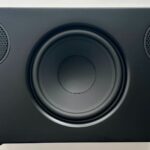Why you can trust TechRadar
We spend hours testing every product or service we review, so you can be sure you’re buying the best. Find out more about how we test.
Hobot S7 Pro: two-minute review
The Hobot S7 Pro is a square robot that clings to your window and cleans dirt away using dual cleaning pads and a fine spray mist. It can be used indoors and out, and is suitable for framed or frameless windows. The large size is well suited to big windows; note that if the pane is too narrow, it won’t clean it at all.
On test, I found this bot did a great job of cleaning lightly dirty glass. It’s easy to use, navigates accurately, and doesn’t miss any spots. However, it struggles with tougher dirt, which is probably true of most window bots. When I used it on the outer panes of my large patio doors, with some water marks and general grime accumulated from being exposed to the elements, the results were a little streaky. In contrast, my indoor glass partitions were left perfectly clean with no smears at all (and the bot accurately detected the frameless edges, which impressed).
The design of the S7 Pro is largely effective, with a few downsides. At time of testing, app support wasn’t available, which meant I had to rely on the remote control. This requires you to point the remote directly at the robot, which is sometimes awkward. I also found the voice prompts shrill and irritating – and there’s no way to switch them off. During my extensive testing period, the bot did once fall off a window.
Price-wise, the S7 Pro is an investment, but roughly in line with the wider market. You won’t be saving much time by opting for this bot and, unlike a robot vacuum, you can’t leave it to do its thing unattended – you need to be around to move it from pane to pane. However, in a home with lots of glass, or glass that needs regular cleaning, it could be a big effort-saver, and worth the investment. That’s the short version; read on for my full Hobot S7 Pro review.
Hobot S7 Pro review: price & availability
- List price: $439 / £329
- Available: US / UK
- Launched: 2025
The Hobot S7 Pro is available in the US and the UK, with a list price of $439 / £329. Solenco – the brand behind Hobot – also has a presence in Australia, but at time of writing, the S7 Pro wasn’t available there. You can buy it direct from Solenco in the UK, and via Amazon in the US, although I suspect it will become more widely available as time goes on.
The S7 replaces the S6 in the Hobot range. Unfortunately, I can’t find the pricing for that model anywhere, and nor can I discern the exact differences between the S6 and S7 models. (I’ve requested the information and will update this review when I hear back.)
A major competitor in this market is Ecovacs with its Winbot line. Models range from around $230-$700 in the US or £300-£500 in the UK. In general, though, the models closest to the S7 seem to be roughly the same price.
The Hobot S7 Pro isn’t an especially cheap alternative to manual window cleaning, but it could be worth the investment if you have a lot of glass to clean, or if your windows get dirty quickly.
- Value for money score: 3.5 out of 5
Hobot S7 Pro specs
|
Size (W x D x H): |
10.5 x 10.2 x 3.5in / 26.7 x 26 x 9cm |
|
Tanks: |
2 x 80ml |
|
Max suction: |
4,800 Pa |
|
Total charge cable length: |
21ft / 6.4m |
Hobot S7 Pro review: design
- Square-shaped bot with dual reciprocating cleaning pads
- Sprays fine mist from two small water tanks
- Controlled via remote control – app support advertised, but unavailable
The Hobot S7 Pro is a square robot with dual reciprocating cleaning pads. It clings to your window and makes its way across its surface to clean it, with the aid of “AI-powered navigation”. This bot is suitable for both framed and frameless windows, as well as patio doors and mirrors. While the following isn’t addressed in the literature anywhere, previous reviews suggest the S7 Pro is only suitable for perfectly vertical surfaces.
Size-wise, the bot is rather large, so better suited to big windows (in fact, it refused to clean a 12.6in / 32cm wide window, I think due to lack of maneuvering room). The brand makes a range of smaller window bots, shaped like elongated ovals, which might be a better option if your windows aren’t sizeable.
On the upper side of the unit is a grip handle for attaching and removing the bot to a surface, plus an on/off rocker power switch and a start/pause press button. On either side are two small, 80ml water tanks, sealed with a rubbery stopper. These can be filled with water and/or Hobot’s own (supplied) cleaning solution; they’re detachable with the aid of a screwdriver. Attached to each one is an “Ultrasonic nozzle”, which sprays a very fine mist into the path of the bot as it moves around the surface. These are apparently extremely sensitive and not to be touched under any circumstances.
Flip the robot over and you’ll find two rubbery caterpillar belts and two removable, washable cleaning cloths. These have rectangular sections cut out of the middle, to leave the suction area the bot uses to cling to the glass free. The cloths are mounted on separate plates, and vibrate vertically in towards each other. Hobot says this simulates the motion of a human hand scrubbing, although with up to 600 “wipes” per minute, it’s rather more frenetic than any window cleaner I’ve met.
On the edges are bumpers to protect your window frames. This model also includes patented Edge-Leakage-Bumper (ELB) sensors, which are designed to make this cleaner suitable for edgeless glass. These sense if there’s a loss of suction as a result of a gap, or if the bot reaching the edge of a pane of glass, and change direction rather than continue over it, breaking the main suction seal and dropping off.
The device needs to be plugged into the mains to work. Thankfully, the cable is nice and long, but you might still need to make use of an extension cord for awkwardly placed outside windows. You’ll also need to keep the backup battery charged, in case of a power outage – this will keep the bot attached to your window for up to around 20 minutes without power.
A safety cable is provided as a further backup if you’re cleaning windows up high. I was pretty lax about attaching this until the bot fell off one of my windows. This only happened once during my extensive testing period, and luckily I was close enough to catch the rope before it hit the ground outside, but I learned a lesson about being diligent with attaching the rope.
Control is via remote. This offers a few different cleaning cycles – with the one you’ll probably want to use helpfully colored in blue – plus options to turn the spray on and off, or manually direct the cleaning path if required. Unfortunately, you need to be pointing the remote directly at the bot for it to register, which can sometimes be tricky to achieve. Ideally, I’d have used the companion app; app support is advertised for this model, but didn’t appear to be available at time of writing.
The bot will also provide information by yelling at you in a rather shrill voice, accompanied by various loud beeps. It needs to be loud to be heard over the suction of the machine, but that doesn’t make it any less irritating, especially given it repeats the same safety instructions every time you turn it on.
Hobot S7 Pro review: performance
- Navigates accurately and doesn’t miss any spots
- Excellent for maintenance cleans, but can smear dirtier windows
- Not especially speedy, but does save on effort
The Hobot S7 Pro’s dual pads vibrate in a reciprocating (linear, side-to-side) motion to clean and buff your windows. The water tanks apply a fine mist onto the surface of the glass, but this is by no means a wet cleaning setup – after cleaning three large floor-to-ceiling windows, the pads were only very slightly damp around the edges.
It’s easy to get started, although if you’re unfamiliar with window-cleaning robots, you might need to watch a video or two to understand how it will work. You need to hold the bot against the window and switch it on manually – at this point the suction will kick in, along with a loud voice prompt, and you can let go.
Then you can start the cleaning run. Unlike, say, a robot vacuum, there’s no need to map anything first: just set off your preferred cycle and the bot will do the rest. I found the S7 Pro navigated my windows accurately, turning after it had bounced lightly against the window frame or sensed a gap in the glass. Route planning is apparently aided by AI, although each of the buttons on the remote launches a specific cleaning pattern, so I’m not exactly sure where the AI comes in.
The water tanks spray jets of mist – from the side the bot is moving towards – at regular intervals (it isn’t “continuous”, as some of the literature on the bot states). Filling the tanks to max gave me enough liquid to clean one side of one pane on my patio door, plus a bit more; but you’ll still have to top these up quite regularly.
The cleaning coverage is excellent: the S7 Pro left only a small margin around the edges of my framed windows. Previous Hobot window-bots have used two circular cleaning pads; the squared-off design here seems much better suited to regularly proportioned windows.
The ELB (Edge-Leakage-Bumper) sensors are designed to make this bot suitable for edgeless glass (explained more in the Design section). I tested it on some indoor glass partitions that have a 1.5in / 4cm gap at the sides, and the feature worked exactly as advertised – the bot stopped short of the wall and changed direction.
In terms of cleaning results, I’d give it a middling score. For lighter, maintenance cleans, it performed very well. Using it on relatively clean windows indoors, the results were excellent, with no smearing.
However, when faced with the dirtier outside panes of my patio doors, the S7 Pro struggled. While windows were left significantly cleaner than they had been, the results were streaky. I could see the path the bot had travelled, and the occasional caterpillar track-mark. Don’t expect the bot to be able to clean off caked-on dirt or bird poo, either.
Overall, I’m not sure that the ultra-fine mist is sufficient to tackle tougher dirt; I think a little more liquid would help. In addition, when using the S7 Pro outside, I could see that much of the mist was getting blown away in the breeze rather than landing on the window.
On dirtier windows, Hobot suggests you run a no-spray cycle first, to buff off surface dirt. I also found a brand video that recommended drizzling a little bit of cleaner solution on clean pads before starting, to help with grip. I found both of these tips improved the results on dirtier windows.
As as side note, the S7 Pro was also an unexpected win for cleaning behind the safety railings on some second floor, floor-to-ceiling windows; an area that’s extremely awkward to clean any other way.
Generally, the bot adhered well to my window, and felt securely attached when giving it a little tug after pausing operations. However, it did once fall off a window, seemingly for no reason.
In terms of timings, Hobot advertises that it will clean an area of 1 square meter in 2 minutes 36 seconds. In practice, a complete, standard cleaning run takes rather longer than that – in my tests, it cleaned a 1.3 square meter pane of glass in around 7 minutes 30 seconds. So you’re not saving a ton of time by opting for this method of cleaning, but you are saving on effort.
In general, like most robotic home assistants, the Hobot S7 Pro doesn’t do as good a job as a human would do with a manual tool. It’s designed for maintenance cleans that can be supplemented by the occasional proper window-wash, rather than to replace humans entirely. Also note that you can’t leave it to clean unattended – you’ll need to be present to move it from pane to pane.
- Performance score: 3 out of 5
Should you buy the Hobot S7 Pro?
|
Attribute |
Notes |
Rating |
|---|---|---|
|
Value |
Not an especially cheap solution, but in line with similar bots on the market. |
3.5 / 5 |
|
Design |
Square-shaped bot with effective dual reciprocating mop pads and ultrasonic spray. Remote control is a little too sensitive, and app control is absent. Voice alerts annoying. |
4 / 5 |
|
Performance |
Easy to use and navigation accurate and complete. Results are excellent on lightly dirty windows, but can smear when encountering more challenging dirt. |
3 / 5 |
Buy it if…
Don’t buy it if…
How I tested the Hobot S7 Pro
I used the Hobot S7 Pro window cleaning robot to tackle various floor-to-ceiling windows, both inside and out. I tested its different cleaning modes, as well as the remote control option. I focused on how clean it left windows, if it missed any spots, and if it could achieve the advertised streak-free finish. I also assessed how easy it was to use, its noise level in operation, and if there were any design features that proved troublesome.
Read more about how we test
Read the full article here













